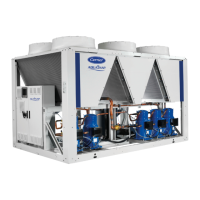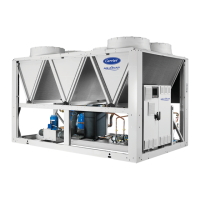
Do you have a question about the Carrier AQUASNAP 30RBP and is the answer not in the manual?
| Compressor Type | Scroll |
|---|---|
| Refrigerant | R-410A |
| Dimensions (L x W x H) | Varies by model |
| Weight | Varies by model |
| Sound Power Level | 85 dB(A) |
| Power Supply | 380 - 415V, 3-phase, 50Hz |
Guidance on inspecting delivered equipment for damage and completeness.
Instructions for safe moving, lifting, and placement of the unit.
Details on unit dimensions, required clearances for maintenance and airflow.
Presents physical specifications and data for 30RB units from 170R to 380R models.
Presents physical specifications and data for 30RB units from 410R to 950R models.
Presents physical specifications and data for 30RBP units from 170R to 950R models.
Provides electrical data including voltage, current, and power for 30RB units.
Pre-start-up verification checklist covering system, safety devices, and installation details.
Procedure for commissioning the unit, including checks on connected equipment and safety devices.
Details on hermetic scroll compressors, their features, and safety components.
Explanation of how variable speed drives optimize fan efficiency and performance.
Overview of the SmartVuTM control interface features and capabilities.
Lists available options for 30RB/RBP and 30RQ/RQP units with their advantages.
Description of the hydraulic module components and fixed-speed pump operation.
Details on the partial heat recovery option for producing hot water from compressor discharge.
Basic maintenance tasks that can be performed by the user, including visual checks and cleaning.
More advanced electrical, hydraulic, and mechanical checks requiring specific expertise.
Provides torque values for tightening various electrical connections on the unit.
Recommendations for cleaning and maintaining air-cooled heat exchanger coils.
Procedure for safely shutting down the unit and separating it from energy sources.
Lists fluids to be recovered, including refrigerant, heat transfer fluid, and compressor oil.
Guidelines for the end-of-life disposal of the equipment as WEEE.
Fields for job details, location, installer, distributor, and start-up date.
Check for shipping damage and its potential impact on unit start-up.
Checks related to the operation and status of air handling units and associated systems.












